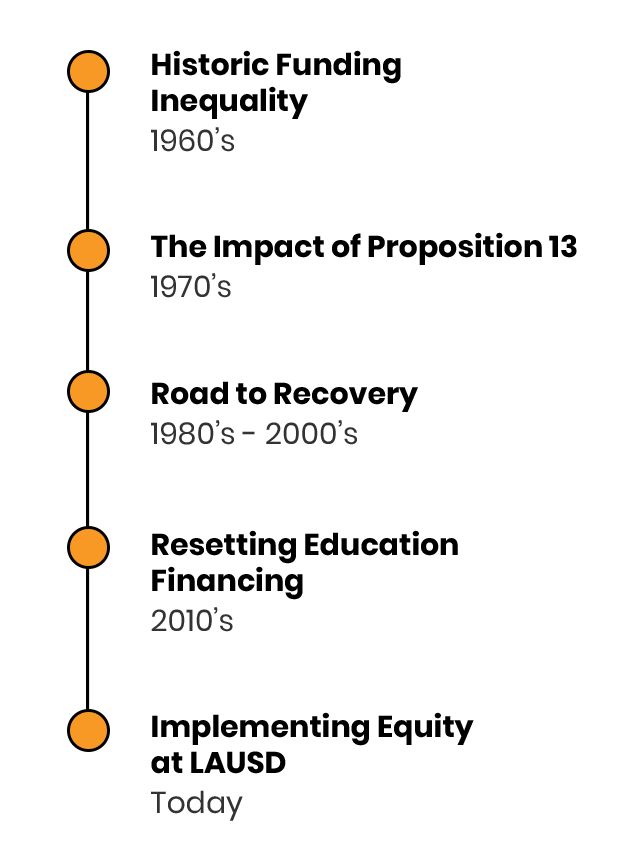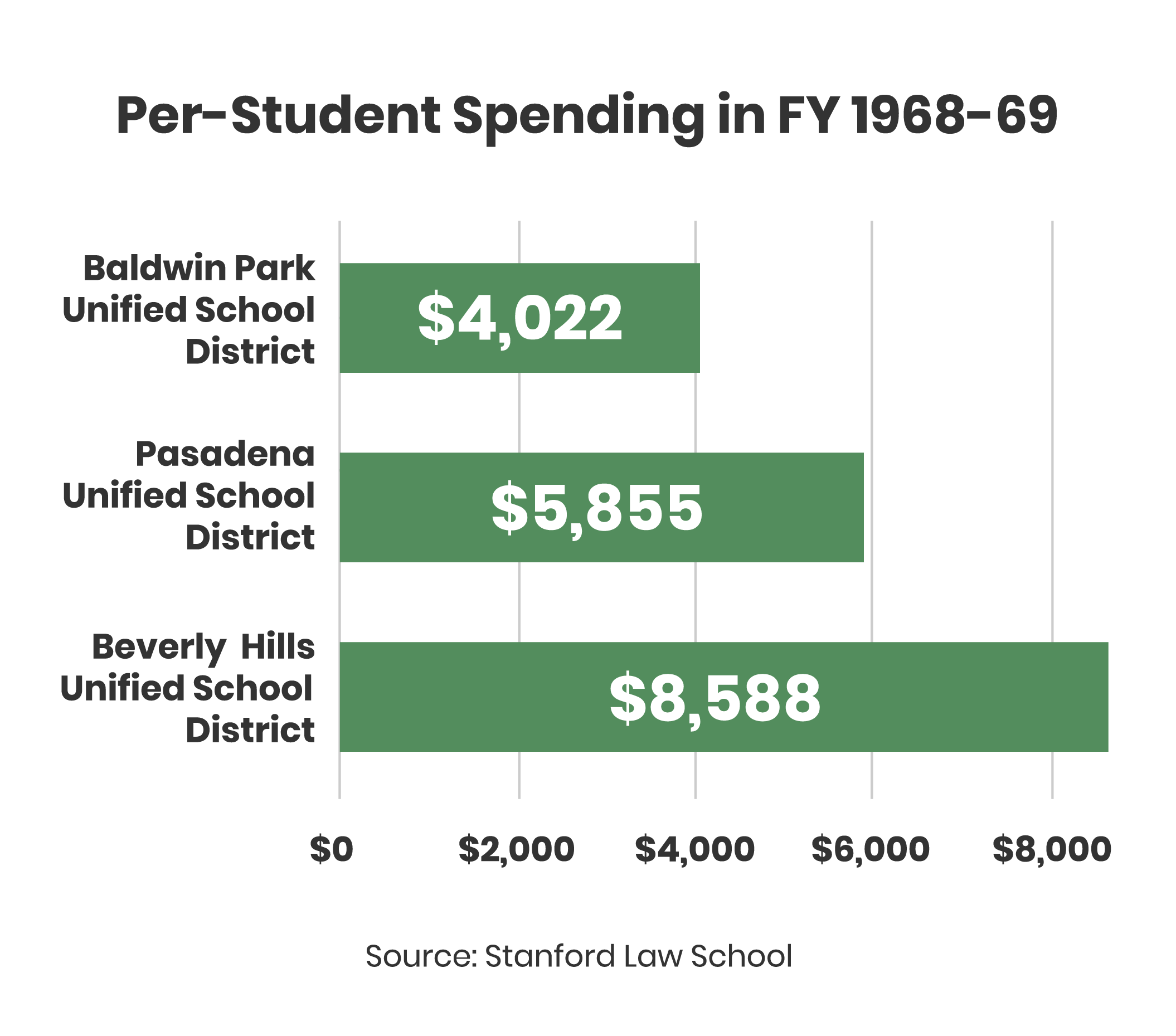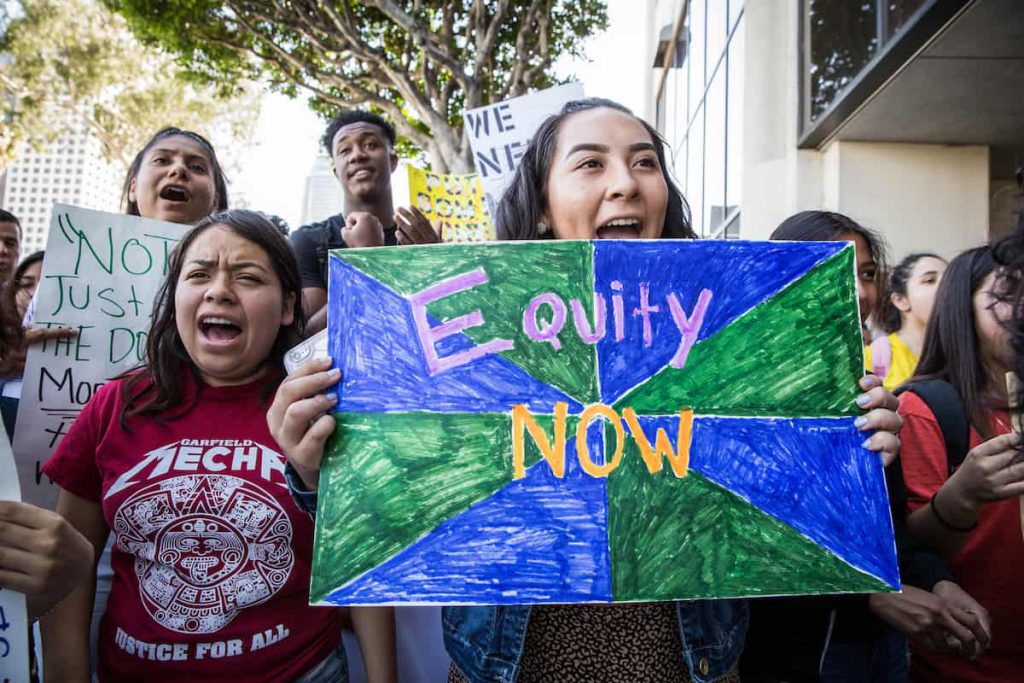594,744 Students
In the 2018–19 School Year, there were 594,744 students enrolled, making it the second largest school district in the nation!
Learn more about the state policy decisions that led to the underinvestment in LAUSD schools. And important information regarding recent educational reforms meant to carry out equity in school funding. This section sheds light on how LAUSD develops its budget, who decision-makers are, plus tips to advocate for more resources at your school.
Equity Advocate
Special Education Advocate
Early Education Advocate

While California ranked high nationally in terms of funding for public education, the amount of funds a student received varied and was determined by the wealth of the neighborhood they lived in.

For example, in fiscal year 1968–69 the Baldwin Park Unified School District spent $4,022 per student; Pasadena Unified School District spent $5,855 on every student; and the Beverly Hills Unified School District spent $8,588 per student (inflation adjusted).
Eventually, courts found California State education financing was unequal and unfair. The State decided to equalize funding regardless of a community’s wealth.
Although spending was equalized, it was far from “fair” because it did not account for varying student needs.
A key ballot initiative–Proposition 13–significantly impacted how schools were funded in California.
Proposition 13 reduced property tax revenues available for school districts and made it harder to upgrade tax laws. This meant that as the student population grew, the ability to increase spending in classrooms became limited. Consequently, California dropped from the top five in student spending to the bottom 10 out of 50 states.
Three more ballot initiatives—Proposition 98 (1988), Proposition 30 (2012), and Proposition 55 (2016)—also played a key role in shaping how schools were funded in California.
While all three improved the educational experiences of students, none linked funding to student needs.
After decades of court battles, legislative tinkering, and community-driven initiatives, California reset education funding by implementing the Local Control Funding Formula (LCFF) in 2013.
The formula includes the following major components:
When California approved LCFF in 2013, Los Angeles parents, students, and advocates expected a good amount of equity funds to go to the highest-need schools. LCFF provided a state-wide framework for districts, but did not specify implementation at the local level. In anticipation, local advocates successfully pushed LAUSD to ensure that the revenue derived by high-need students reached the highest-need schools and students through the Student Equity Needs Index (SENI) 2.0 version in 2018.
SENI 2.0 takes into consideration community factors such as exposure to gun violence and asthma severity rates. This allows for schools to address historic trauma students experience outside the school environment that substantially produce negative effects on our student’s ability to learn, especially in communities of color.

The SENI 2.0 utilizes a tiered system based on a variety of student and school-based indicators to determine highest-, high-, moderate-, low- and lowest-need schools. The new index considers the following indicators of need:
Once the rankings were established, LAUSD allotted $281 million to school sites in the 2019–20 school year, using the SENI 2.0 equity-based funding formula.
Principals were provided with an evidence-based “menu of options” that have been demonstrated to improve student outcomes, which has allowed flexibility for spending SENI 2.0 dollars on meeting the needs of their school and students.
For more information about SENI 2.0 visit the Equity Alliance for LA’s Kids website.
Across communities, there is a growing belief that the most important stakeholders for school funding are those closest to classrooms—parents, teachers, administrators, community advocates, and students themselves.
Beyond the figure of $7.3 billion, LAUSD’s budget is hard to understand for stakeholders. To date, there is no public data source that details spending or how investments translate into real-world experiences for students and families.
Budget is critical for improving students’ educational outcomes in LAUSD.
In the 2018–19 School Year, there were 594,744 students enrolled, making it the second largest school district in the nation!
LAUSD operates over 1,000 school sites! This includes 228 independent charter schools operating within LAUSD.
LAUSD employs over 63,500 people—38% of which are K–12 teachers. The remaining staff make up educational administrators, teacher assistants, and other staff.
Of the 594,744 students enrolled, Latinx students make up 74% of the enrolled student population. Followed by 10% white, 8% Black, 4% Asian, 2% Filipino, and 2% two or more races, 0.2% American Indian or Alaska Native, and 0.2% Pacific Islander students.
The LCFF high-need student population makes up 98.5% (duplicated) of the student population. 13.6% of students are students with disabilities; these students are not considered in LCFF state guidelines.
Using the SENI 2.0, a concentration of the highest-need schools are in the southern, central, and eastern part of the District. This categorization of “high need” also considers community data such as gun-injury and asthma rates.
Given the level of student need, most individuals have had limited access and ability to understand how LAUSD is supporting students through education spending…until now! This easy to use tool will walk you through how the budget is developed and how money is allocated to local schools.
Each one of these entities plays a role in the budget development process.
LAUSD’s fiscal year begins on July 1 and ends June 30.
Attend School Board meetings where the budget is often discussed from April through June and public comments are taken.
The Local Control Accountability Plan (LCAP) provides parents and community residents with the best opportunity to submit feedback on a portion of the District’s budget through the following committees:
While these two opportunities hold opportunities for input, LAUSD could do more to better engage the community and listen to their needs and ideas.
A school’s budget begins every year on July 1st and ends June 30th.
Principals are encouraged to engage students and parents in between February and March.
Below are a few formal ways by which schools obtain feedback on school priorities:
LAUSD manages several types of funds.
For the purposes of our analysis, we will focus on the General Fund since it is the most flexible.
Main Takeaway: Seventy-six percent of LAUSD’s revenues comes from the State’s Local Control Funding Formula (LCFF). Federal government revenues make up a much smaller share of LAUSD’s budget.
Fun Fact: Only 1% of the LAUSD’s revenues come from the California State Lottery system.
$7.3 Billion Wow! That’s a lot of money. Yes, it is! LAUSD’s budget is almost the same as how much all four Avengers movies grossed ($7.8 Billion).
Main Takeaway: Twenty percent of LAUSD’s LCFF revenues were derived because of the concentration of High-Need Students attending LAUSD. These funds are supposed to be accounted for in the District’s Local Control and Accountability Plan (LCAP).
Main Takeaway: Sixty-three percent of LAUSD’s federal revenues comes from Title I, II, III grants which are primarily directed to low-income, immigrant, and English learner students and for teacher professional development.
In Fiscal Year 2019–20, LAUSD only received $500 million for special education, 71% of which came from the state and 29% from the federal government.
LAUSD is expecting to spend $1 billion on special education – the district is supplementing these additional costs by using LCFF funds to resource programs.
LAUSD offers 86 Early Education Centers (ECE), a pre-school program, to children ages 2 through 4 from low-income families or those who have a qualifying need.
These centers are primarily funded by the Child Development Fund, a state revenue source. In 2019–20, LAUSD is projecting to spend $30 million from the Fund to operate these centers.
Main Takeaway: As with all school districts expenditures for teachers, administrators, maintenance staff—and their benefits—amounts to 79% of all spending by LAUSD. The remaining 21% pays for books and supplies, services and contracts, and capital projects.
For more LAUSD budget information visit our District Profile.
The purpose of the Local Control and Accountability Plan (LCAP) is to provide the community with an annual update on how LCFF resources—especially equity funds—are being spent.
The following is an analysis of LAUSD’s 2019–20 LCAP:
Despite its size, LAUSD’s LCAP is vague and makes assumptions that readers will understand technical nuances. Our key takeaways include:
Major LCAP Expenditures:
Main Takeaway: The $1.1 billion designated for targeted students is collapsed under the $5.2 billion total spending figure. LAUSD bundles spending under large categories and does not clearly explain how it uses equity-dollars on services to benefit targeted students.
Main Takeaway: LAUSD does not clearly explain how it uses equity-dollars on services to benefit schools with high concentrations of targeted students. Consequently, it is unclear how the LCAP and the annual budget process at school sites link with each other.
Here is a guide to help you become a budget advocate at your school. Before you dive in, get to know who the important players are at your local school.
Principal: Each school is run by a principal who ensures that a school’s day-to-day operations run smoothly. They are tasked with developing their school-site budget to pay for the needs of students and teachers at the school site.
Assistant Principal: The assistant principal is in charge of the implementation of school priorities in support of the school-wide vision. They play an active role in investing and mobilizing teachers to achieve the collective goals of the school. Some schools have more than one assistant principal.
Parent Liaison/Coordinator: This individual may be tasked with outreach to parents and students and share important information about a school’s activities and programs.
Teachers: They have firsthand knowledge about students academic needs and their development.
Front Office Staff: They keep the office running and manage the meeting schedule for the principal and assistant principal. They often know the calendar of events at a school, many of the teachers and staff, and can be a good resource for navigating the school.
Starting off, know your ask:
Next, know what to say:
And, where to say it:
You may get resistance—that’s OK.
Learn more about the ways the COVID-19 epidemic is impacting how LAUSD teaches students and makes its budget.
On March 16, 2020, LAUSD closed its schools to limit the spread of COVID-19 and moved instruction online (distance learning). While this action helped protect the district’s students and staff, it created enormous disruptions. Teachers and students needed to quickly adapt to new methods of instruction and learning. This swift pivot also placed new strains on the district’s budget just as the economy headed into a recession.
Equity issues for distance learning are numerous. The technology required for distance learning is not equally available to all students, and free devices and internet access may come with privacy trade-offs and future costs.
Distance learning also means that students who require additional support from teachers and staff will not receive services in the same way. Students without permanent housing, students with disabilities, and English language learners face additional access barriers. Underlying health disparities, like asthma, also mean some members of the LAUSD community are at higher risk from the disease.
It remains unclear whether some forms of distance learning will continue once LAUSD re-opens in the Fall, meaning that these equity issues may become long-term challenges.
Explore data on highly-impacted student populations using WeBudget’s School Profiles.
Read more about equity issues in distance learning in our policy brief “Overcoming the Distance: Promising Practices to Center Equity in Implementing Distance Learning.”
Responding to the shift to distance learning, the district allocated $100 million to provide devices and internet access to students through a partnership with Verizon. Serving as a makeshift safety net, LAUSD also launched a mental health hotline and provides meals to Los Angeles residents regardless of age or socioeconomic status. All told, through the end of the 2019-20 school year, the district will spend over half a billion dollars responding to COVID-19, and will need to spend even more to re-open schools in the Fall.
Beyond these additional costs, the Governor has proposed cuts in state funding that could reduce the district’s revenues by 7%. The district must decide how to continue critical services amid a budget deficit. In June, the Board will pass an preliminary budget with estimates and projections based on current and available information. The full impact may not be known until August or later, so budget revisions both district-wide and at specific schools are expected through the Fall.
Read more about equity issues in local budgeting, including school districts, in our policy brief “Meeting Crisis With Courage: A COVID-19 Playbook for Advocates and Policymakers.”
Parent and student voices will be harder to hear and gauge amid school closures. While alternate methods such as phone or virtual meetings are available, sufficient translation and interpretation services may not be available—which will leave out many families.
In the meantime, advocates, parents, and students can contact Board offices directly—click here to contact your Board member– and some schools are holding community meetings online. Local districts are also bringing multiple schools together for more effective communication and engagement—click here to contact your Local District.
Community organizations are keeping lines of communication open between LAUSD and its community. These are important resources for parents, students, and LAUSD staff: